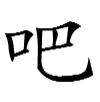吧
| ||||||||
Translingual
| Stroke order | |||
|---|---|---|---|
 | |||
Han character
吧 (radical 30, 口+4, 7 strokes, cangjie input 口日山 (RAU), four-corner 67017, composition ⿰口巴)
References
- KangXi: page 178, character 4
- Dai Kanwa Jiten: character 3341
- Dae Jaweon: page 395, character 12
- Hanyu Da Zidian: volume 1, page 596, character 6
- Unihan data for U+5427
Chinese
Pronunciation
Definitions
吧
- Emphatic final particle; used at the end of a sentence to
- indicate a suggested action: why don't you ...
- express imperative mood: let us ...
- indicate a speculation.
- indicate a suggested action: why don't you ...
- Used at the end of a sentence used to concede a point.
- Used after the topic for emphasis.
Usage notes
- 吧 is not usually used as a modal particle in Min Nan. The particle 乎 (hohⁿ) provides a similar effect.
Pronunciation
Pronunciation
Pronunciation
Definitions
吧
- bar
- 迪吧 ― díbā ― disco
- Short for 貼吧/贴吧 (Tiēbā, “internet board”).
- transliteration character
- 迪吧 ― díbā ― diva
Pronunciation 1
Definitions
吧
- Only used in 吧呀.
Pronunciation 2
Definitions
吧
- Only used in 吧呀.
Japanese
Kanji
吧
- This term needs a translation to English. Please help out and add a translation, then remove the text
{{rfdef}}.
Korean
Hanja
吧 • (pa) (hangeul 파, McCune–Reischauer p'a)
- This term needs a translation to English. Please help out and add a translation, then remove the text
{{rfdef}}.
This article is issued from
Wiktionary.
The text is licensed under Creative
Commons - Attribution - Sharealike.
Additional terms may apply for the media files.